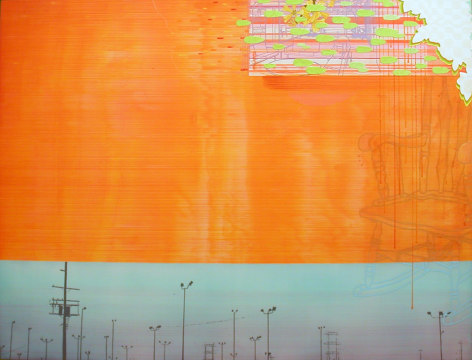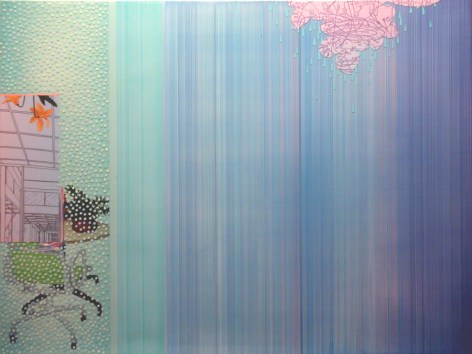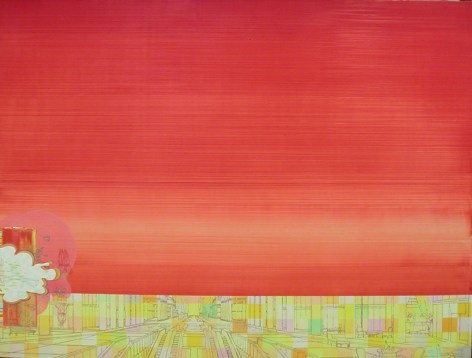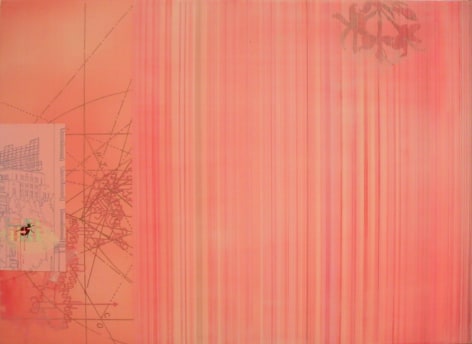The pictures in Dion Johnson's paintings are so clear and distinct that dogs and cats could
understand them. That's one reason why critics who like their art to be obscure and difficult
(all the better to flaunt their brainy ability to translate it) have so little to say about works like
these, in which simple things are presented in such a straightforward manner that you'd have to be
doofus to miss the point. This tells us two things about Johnson's paintings:
1.) They have consequences. Looking at them is risky business because they remove the safety
net provided by the illusion of detached observation. They also eliminate the bet-hedging
relativism that accompanies standard ideas about art's identity as an incomplete entity in need of
interpretation - the more complicated and multi-layered the better. Johnson's profoundly
superficial works are not codes to be cracked nor signs to be deciphered nor texts to be analyzed.
Public utterances, they are concrete (and fairly sophisticated) instances of civilized sociability.
As such, they take decorum seriously. Refusing to separate matters of taste from larger questions
of manners, they do not concern themselves with private sentiments or unbecoming intimacies.
Instead, they invite one-on-one interactions, inciting viewers to behave in a variety of ways.
Whether you love them or hate them you have some kind of reaction; even middle-of-the-road
responses stand apart from the distant, uncommitted analyses often elicited by works of
contemporary art - and monotonously delivered by commentators of a conceptual (i.e.,
contemplative) bent. In every case, Johnson's unguarded yet well-heeled paintings hit us where
we live. Throwing their lot in with all types of social events, from casual encounters to highly
formalized exchanges (and everything in between), they traverse the fully visible world. Rather
than conveying neat morsels of meaning, Johnson's works lay all of their elements out on
beautifully crafted surfaces so that everything is visible all at once. Their immediately
recognizable images and vivid painterly incidents don't force viewers to dig out secret tidbits of
significance (in the manner of painstaking archaeologists). Nor do they presume that looking at
art has anything to do with uncovering emotionally loaded symbols (in the manner of tenacious
psychoanalysts). Likewise, they eschew the idea that art gets us to re-live momentous, lifedefining
traumas (as if art-viewing were some sort of therapy and viewers were patients in need
of healing). On the contrary, Johnson's levelheaded works simply set your eyes in motion.
Gliding across variously applied swoops, swishes, and smears of paint, your optical organs gain
speed, momentum, and energy as you rediscover what it's like to see the ordinary stuff of
everyday life anew - with the fresh-eyed enthusiasm of the first time.
2.) Specialists and professionals are in no better position to respond to Johnson's user-friendly
works than is anyone else. (In fact, approaching these simple but far from simplistic pictures
encumbered with the idea that meaning is an inert, passively transmitted entity puts one at a
distinct disadvantage.) Being curious about one's surroundings and the relationships that take
shape among their myriad components is all that Johnson's acrylics on canvas and plexiglass
demand. In the end, this turns out to be quite a lot. The shamelessly playful appearance of these
unpretentious paintings doesn't prevent them from making deeply serious, quasi-philosophical
propositions. Before them, it becomes clear that meaning does not originate from above
(in some transcendent realm of Timeless Ideals) and then trickle-down to earth-bound viewers.
Instead, it springs up from below, percolating through life's imperfections to brew more timely
truths. Most important, Johnson's paintings make this proposition by showing rather than telling:
They change a viewer's relationship to highfalutin ideas by locating such ordinarily ungraspable
abstractions in the present, however unglamorous and incomplete it may be. Never appealing to
the authority of historical precedents or to the ideas out of which they grew, these humble works
appeal only to the responses they generate. In them, everyday scenarios, recognizable objects, and
easy-assembly diagrams appear alongside a pretty thorough cataloging of the various ways paint
can be applied to a flat surface: brushed, combed, squirted, and squeegeed - even sculpted, cut,
and collaged. Viewers are thus compelled to participate in the unscripted stories that unfold
before them. Bringing grand aspirations and wild ambitions down to earth by emphasizing just
how extraordinary ordinary things can be, Johnson's refreshingly accessible pictures put the Pop
back into populist. Imagine an old TV on the fritz and you'll have an idea of the out-of-sync
scrolling flow that occurs when you look at these works. Then imagine that your set is picking up
about a dozen channels simultaneously - that, as the out-of-frame images jitter and roll across the
screen, they also flip from one program to another. This will give you an idea of how clunky and
plodding ordinary channel surfing is when compared to what takes place before Johnson's
animated paintings. Here, worlds do not collide as much as they momentarily frame one another,
gracefully segueing from one to the next. As your glance drifts across the smartly edited surfaces
of these pictures, elements that are the stars of some scenes become the supporting casts in others.
Things shift position with impressive equanimity. Plastic ants, coloring-book kids, and the daring
men of the flying trapeze have plenty of room to maneuver - and leave plenty of room for
viewers. The sweet appeal of Johnson's candy-colored palette and PG subject matter goes handin-
hand with the desire to draw viewers into open-ended dramas that begin with benign banalities
but whose outcomes are neither. Behaving as if nothing were more scintillating than the little
fugitive pleasures we sometimes steal from the jam-packed schedules that make up our lives of
constant, multi-tasking busyness, these paintings make room for aimless play. Surreptitiously
sneaking into the gaps between tasks and duties, commitments and obligations, they redeem lost
moments by giving form to time spent doing nothing in particular, when unformed notions drift
in and out of focus, sometimes giving birth to full-blown thoughts and at other times providing
more mysterious satisfactions. Johnson's endearing images bring innocence back into the picture
not by traveling back in time but by making space, in the present, for daydreams whose pleasures
are as intangible as they are undeniable.
-- David Pagel




